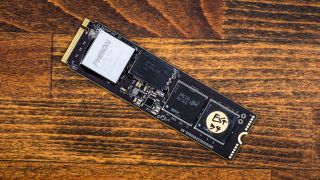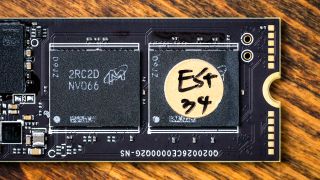Phison E26 SSD Preview: PCIe 5.0 SSDs Are Finally Here
The fastest drives are just around the corner

The Phison PS5026-E26 SSD controller will bring PCIe 5.0 performance to the masses in Q1 of this year. Our reference design sample pairs it with Micron’s new 232-layer TLC, which improves upon the excellent 176-layer NAND flash utilized in a wide range of products. The result is unprecedented sequential speeds and immense potential IOPS, although these do not come without some caveats. High-end PCIe 5.0 drives will require proper cooling and the right platform to reach and maintain the best levels of performance.
Our Phison E18 controller preview from mid-2021 demonstrated that Phison was serious about bringing top-tier performance to consumers earlier than other controller manufacturers. The E26 reflects this mindset and manufacturers will begin to advertise SSDs based on the controller sooner rather than later. PCIe 5.0 drives can offer very high levels of sequential performance, but the newer controllers can also raise the IOPS bar for heavier workloads, blowing away all the PCIe 4.0 contenders on our current list of the best SSDs. This is not too surprising as the E26 is based on an enterprise controller design, and in fact it has optional enterprise features.
These drives will also be among the first with cutting-edge flash which will improve latency and power efficiency. We did not see direct benefits with the E26 in these two areas, but the technology will be optimized and the future DirectStorage API should also benefit from the additional all-around speed improvements. For now it does feel a bit like overkill, but pushing the limits is necessary to make use of increasing PCIe bandwidth. This drive shows that it can leave PCIe 4.0 solutions in its dust.
Specifications
| Tested Capacity | 2TB |
|---|---|
| Form Factor | M.2 2280 |
| Interface / Protocol | PCIe 5.0 x4 / NVMe 2.0 |
| Architecture | Dual-R5 & Triple CoX |
| Process | 12nm |
| Bus | 8-channel (32CE), up to 2400 MT/s |
| Controller | Phison PS5026-E26 |
| DRAM | SK hynix LPDDR4 |
| Memory | Micron 232-Layer TLC (B58R) @ 1600 MT/s |
| Sequential Read | Up to 14,000MBps |
| Sequential Write | Up to 11,800MBps |
| Random Read | Up to 1,500K |
| Random Write | Up to 2,000K |
| Security | AES-256/SHA512/RSA4096, Opal 2.0/Pyrite |
| Firmware | RC2; I/O+ Technology |
| Optional | Dual Port, SR-IOV, ZNS, up to 64 NS |
The Phison E26 ES (engineering sample) SSD is rated for up to 14,000/11,800MBps for sequential read and write and 1,500/2,000K IOPs for random read and write, both respectively. This is a PCIe 5.0 SSD and is capable of almost double the sequential read performance of previous-generation, PCIe 4.0 SSDs that use the Phison E18 controller. Maximum IOPS has also increased significantly. Actual performance is dependent on the flash type and amount of flash, as well as the platform. In fact, performance variance may be more significant with PCIe 5.0 SSDs, and even come down to which M.2 or PCIe slot is utilized for the drive.
The Phison E26 controller is based on the enterprise E20 controller used in Phison’s X1 SSD solution and it therefore has optional features not commonly available in client products. This includes encryption but also SR-IOV, ZNS, and up to 64 namespaces support. This is coupled with Phison’s I/O+ Technology which is designed for DirectStorage gaming, first implemented in the Sabrent Rocket 4 Plus-G. Our sample SSD is using Release Candidate 2 (RC2) firmware and is not a retail sample. Performance for this controller may also improve with faster flash.
Software and Accessories
Software support will depend on the individual manufacturers which choose to use the Phison E26 controllers in their SSD products. Free software for benchmarking, health monitoring, and imaging are widely available, but many manufacturers prefer to offer their own SSD toolboxes to provide firmware updates. Heatsinks may be considered accessories if they are self-applicable, but PCIe 5.0 drives are bound to run hot so will typically arrive with a heatsink pre-installed.
A Closer Look



Our E26 SSD sample (ES) arrived with an actively-cooled heatsink. This is a necessity to keep high-performance drives from overheating, although proper passive cooling may be sufficient. Active cooling is not always desirable as small fans can be noisy and present another point of failure to the product.
Stay on the Cutting Edge
Join the experts who read Tom's Hardware for the inside track on enthusiast PC tech news — and have for over 25 years. We'll send breaking news and in-depth reviews of CPUs, GPUs, AI, maker hardware and more straight to your inbox.
Underneath the heatsink the Phison E26 controller is paired with a memory module, four NAND packages, and Phison’s power management integrated circuit (PMIC). This is not an unusual layout for high-end Phison drives - the Phison E12 controller also only mounted up to four NAND packages until it was later shrunk with the E12S revision. This could limit capacity to some extent but the controller is designed for 1Tb/128GB dies with 32 of them being optimal, easily manageable with four NAND packages.


The E26’s architecture is similar to Phison’s previous controllers, utilizing a dual ARM Cortex-R5 design with triple-core CoXProcessors. The R5 is a proven basis for the majority of consumer SSD controllers but some based on the Cortex-R8 are showing up on the market. This includes the SM2269/XT in the Solidigm P41 Plus and the SM2264 in the ADATA Legend 960. The R8 is more powerful and has more features than the R5, but Phison believes the R5 makes more sense for scalability. This works particularly well with its co-processor design which offloads common processes.
The memory is SK hynix H9HCNNNCPUMLXR-NEE which is 32Gb/4GB of LPDDR4. This is lower-power memory but is also larger in capacity than what is typical for a 2TB drive. The E26 can easily handle 4TB of flash and there’s also a free spot for a second memory package on the PCB’s rear. Some NVMe 2.0 features could make use of extra memory on the SSD while on the other hand some, like Zoned Namespaces (ZNS), can reduce memory overhead. 4GB makes sense for an ES and the extra amount has no bearing on our testing today.

The flash modules are labeled NV066 which is Micron’s 232-layer TLC (B58R), a generational improvement over the now-ubiquitous 176-layer TLC (B47R). These modules are 4Tb/512GB each for a total of 2TB. Micron’s 232-layer TLC uses 1Tb/128GB dies so each package has four dies (4DP) for a total of sixteen, which provides per-channel interleaving but peak performance would be with thirty-two at 4TB. Inter-die interleaving is improved with this generation of flash as each die has six planes rather than four. All else being equal, this should lead to at least a 50% improvement in maximum performance.
Along with the addition of more planes, it is expected that 4K read and write latency will be improved. Micron implements independent plane reads with this architecture, a technique used in its 176-layer QLC to good effect with the Crucial P3 and Crucial P3 Plus. The independent word-line technology was introduced with its 176-layer TLC, first spotted on the Crucial P5 Plus. This particular 232-layer flash is running at an I/O speed of 1600 MT/s but is capable of 2000 and 2400 MT/s.
MORE: Best SSDs
MORE: Best External SSDs and Hard Drives
MORE: How We Test HDDs And SSDs
MORE: All SSD Content

Shane Downing is a Freelance Reviewer for Tom’s Hardware US, covering consumer storage hardware.
-
DavidLejdar Nice. I have my MB ready for it, AM5, so no taking away of PCIe 5.0 lanes from the GPU. And for casual use it sure seems quite over the top these days - and more so when there is a relatively weak CPU, since such is not likely to make full use of the 4K-random-read IOPS. But as this controller allows for up to 32 TB capacity, that is quite some potential to hope for reasonably priced at least 4TB or even 8TB drives.Reply -
cyrusfox Going to have a hard time to make use of 10GB+/s transfers, 1-2GB/s is plenty, usually don't experience speeds in excess of SATA in actual day to day usage.Reply
Very interested to see how this controller stacks up to best gen4 drives as well as how it compares to the aging and last of the line Optane 5800x. Fully expecting diminishing returns. For mobile though, does 2xlanes PCIe gen 5 take more or less power than 4 lanes PCIe gen 4? That is one application where gen 5 might make sense. -
TechieTwo A year of hype and at least six months late to market with so, so performance. Caveat emptor.Reply -
setx Power consumption is horrible.Reply
What is this drive designed for? For home I'd rather have cool PCIe 4 SSD. For work (saving data from high-speed cameras) sustained write is unacceptable. -
Math Geek what i wonder about most is how do these run so hot? i mean <12w at full throttle is not that much. just trying to figure out how it takes active cooing for very little power used overall. the drive acts like its using 100w.....Reply -
DonQuixoteIII Early days yet, but already the nemesis of quiet is raising its ugly head. If these SSDs require active cooling to avoid throttling, tthen hopefully MB mfg's will re-arrange placement of M.2 slots for easier heatsink placement. Of course, not everyone will need (or want) five of these for their use case (four in a RAID with a spare for redundancy), but there will be some, mostly using workstation level MB's, that do. As well as a few well heeled gamers 'just because'. 28kGBs... Woot!Reply -
bit_user Keeping in mind this is an engineering sample, I think it's pretty impressive.Reply
The first thing that needs to be addressed is why the left side of this graph isn't zero. Since I didn't notice that on any other graph, I'm guessing it was a mistake/oversight:
Next, I found it interesting that it doesn't really pull ahead at sequential reads, until the transaction size reaches 128 kB. Not saying it's a problem, just interesting. Nice that it peaks already by 1 MB, but the subsequent drop seems truly bizarre.
The story with sequential writes is a bit better, although you generally care about that less, since the OS can already buffer short busts at even higher speeds:
Power Consumption is clearly its Achilles heel, using nearly 2x the Samsung 990 Pro's full power mode!
That said, another (lesser) trouble spot is in IOPS and random performance. Hopefully, those areas can be polished a bit, prior to launch.
Anyway, thanks for the preview! It's interesting to see how much difference it made in the application benchmarks. Nice to see it noticeably pull ahead in something more than pure synthetics!
Most Popular


